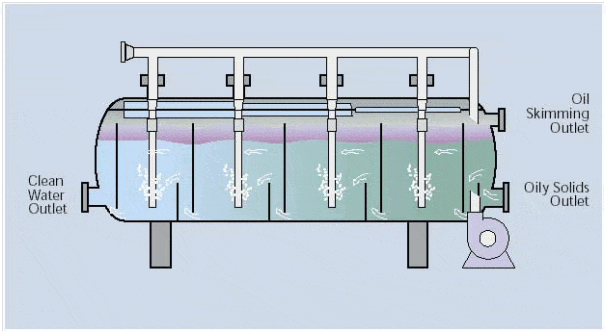(IGF) is a water treatment process that clarifies wastewaters (or other waters) by the removal of suspended matter such as oil or solids. The removal is achieved by injecting gas bubbles into the water or wastewater in a flotation tank or basin. The small bubbles adhere to the suspended matter causing the suspended matter to float to the surface of the water where it may then be removed by a skimming device.
Induced Gas Flotation is very widely used in treating the industrial wastewater effluents from oil refineries, petrochemical and chemical plants, natural gas processing plants and similar industrial facilities.
IGF Units in the oil industry do not use air as the flotation medium due to the explosion risk. These IGF Units use nitrogen gas to create the bubbles.
Oil Floatation is widely accepted technology within Oil & Gas industry as a preferred method for removing suspended oil (Free Oil) from produced water when oil concentrations need to be removed from several hundred ppm to sub twenty -fifteen ppm. To treat produced water for overboard discharge or reinjection, the Gas Flotation Unit delivers a high degree of hydrocarbon removal. The GFU removes dispersed and dissolved hydrocarbons, heavy metals, colloidal particles and aromatic components.
Produced water is the water that comes out of the well along with crude oil. The oil water ratio changes as the well ages and may reach even 90 %. This water needs to be disposed off or re-injected into well but oil suspended in it needs to be removed before hand. Gas Floatation units separate oil very economically and recover valuable oil too.
Though Gas Floatation has been proven commercially successful in role of secondary produced water treatment and has greater role to play due to following reasons:
- Increased volumes of produced water fro older reservoirs
- Increase use of Enhanced Oil Recovery (EOR) techniques
- Increase in production from non conventional reserves like Heavy Oil, Sand Oil etc.
- Increased demand for the re-use of produced water (re-injection, steam generation etc.)
- More stringent environmental regulations are in place throughout the world.
Operating Principle:
IGF units are hydraulically-operated Induced Gas Flotation Units that provide efficient oil recovery from water streams with complete process containment. Oil recovery is achieved efficiently and economically, with operator and environmental safety ensured by the fully enclosed flotation process.
IGF Units separate and recover oil and fine solid particles from water through the creation of fine gas bubbles (typically < 50 microns in diameter), that are dispersed through the incoming water stream. Oil and fine solid particles that are present in the water stream adhere to these gas bubbles and fl oat to the surface where they are skimmed off.
The gas bubbles are dispersed into the incoming water stream by recirculating a side stream of clean water from the outlet of the IGF Vessel and pumping this back through an Eductor.
The high velocity through the Eductor induces gas into the recycle water stream, where the water and gas are mixed and sheared to create a dispersion of small gas bubbles in the water.
The creation of small gas bubbles (typically < 50 micron) results in efficient recovery of small oil droplets present in the water stream due to:
- High probability of bubble/oil attachment,
- High bubble concentration,
- Large surface area / volume ratio of bubbles,
- Low bubble rise velocity/less turbulence,
- Increased volume of oil and solids removed with low gas consumption.
The IGF Recirculation system incorporates a re-circulating loop, where a side-stream of clean water is taken from the outlet of the IGF Vessel, and pumped through an Educator.
The Educator creates a gas-rich fluid stream of small bubbles that is fed back into the IGF unit and dispersed through the water.
Flocculant or flotation chemicals can assist in oil and or solids removal by Induced Gas Flotation.
Benefits associated with properly designed and implemented IGF systems include:
- Low or nil chemical consumption,
- Low operation and maintenance manpower,
- Removal of oil down to
- Removal of fine solids (
- No internal moving parts.
The IGF system has no internal moving parts, which significantly reduces maintenance downtime. The Pump and Eductor are externally located for easy access.

